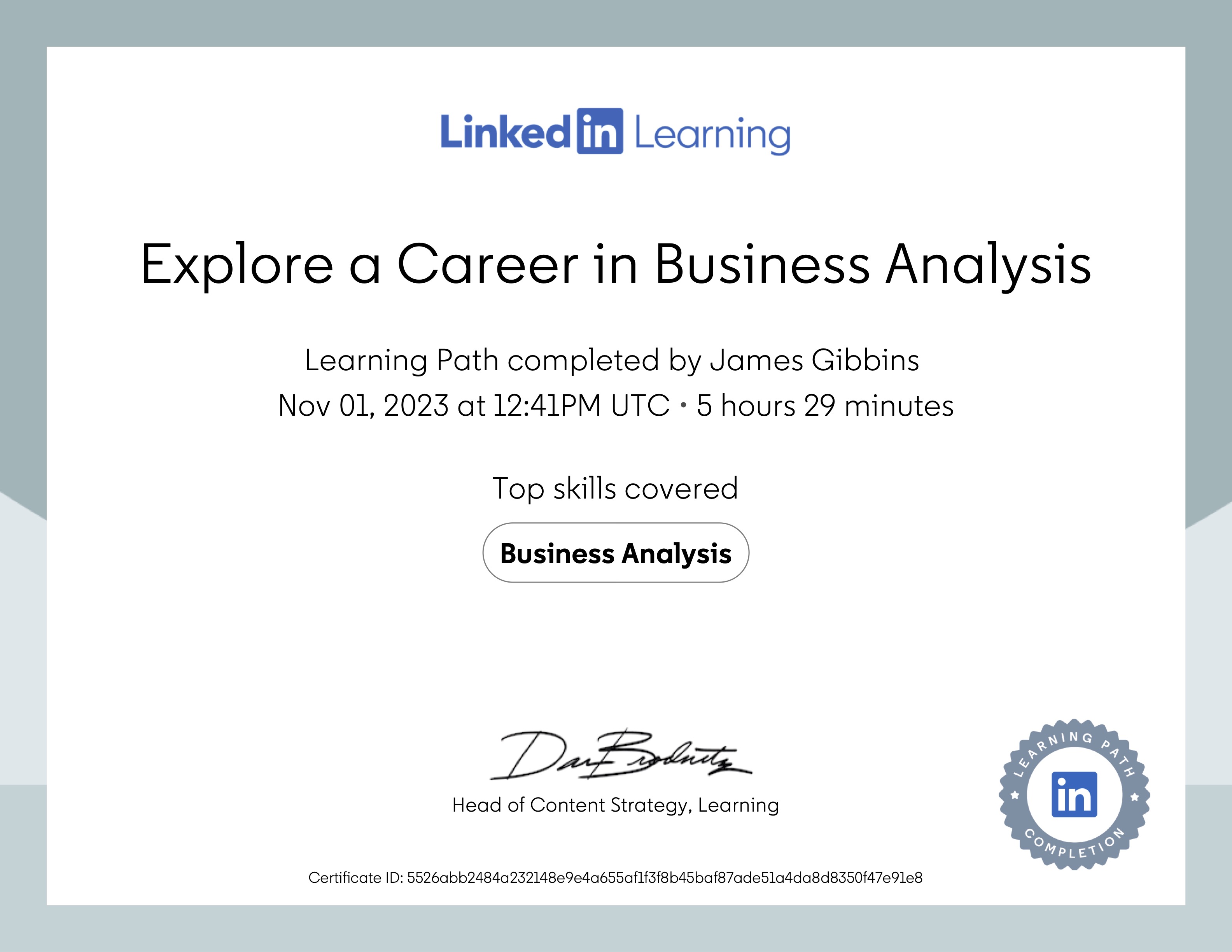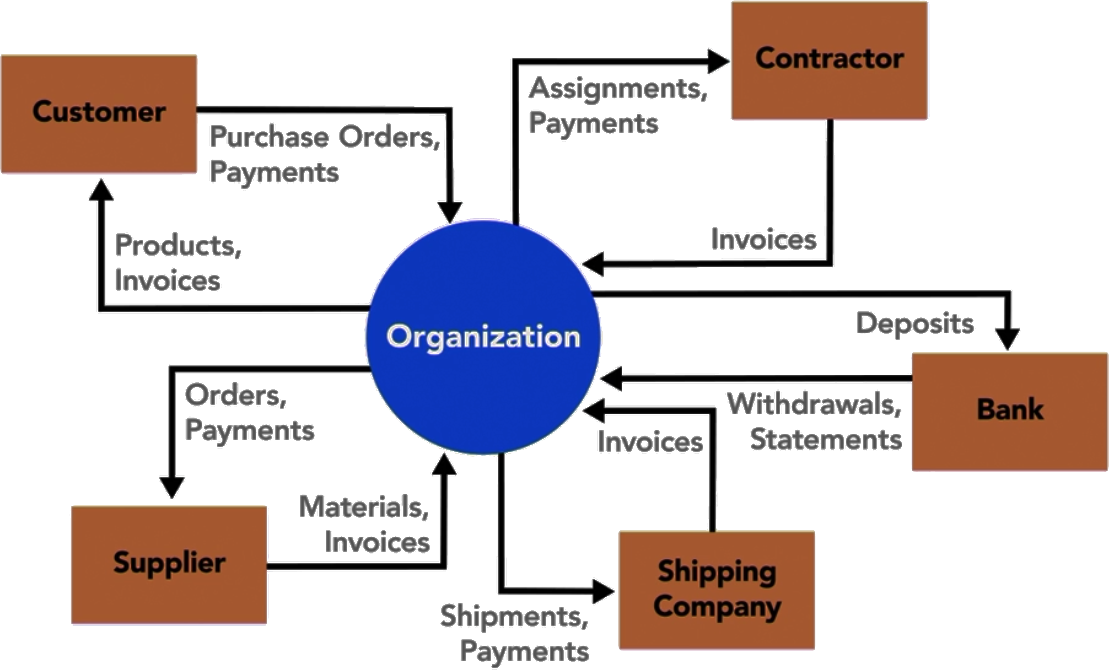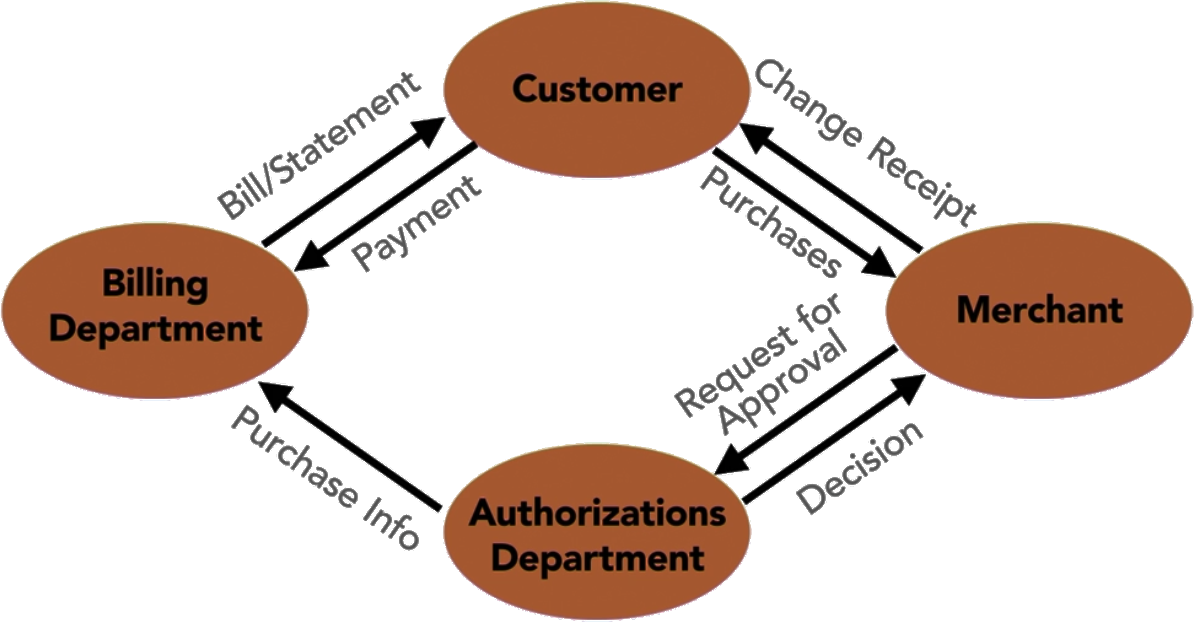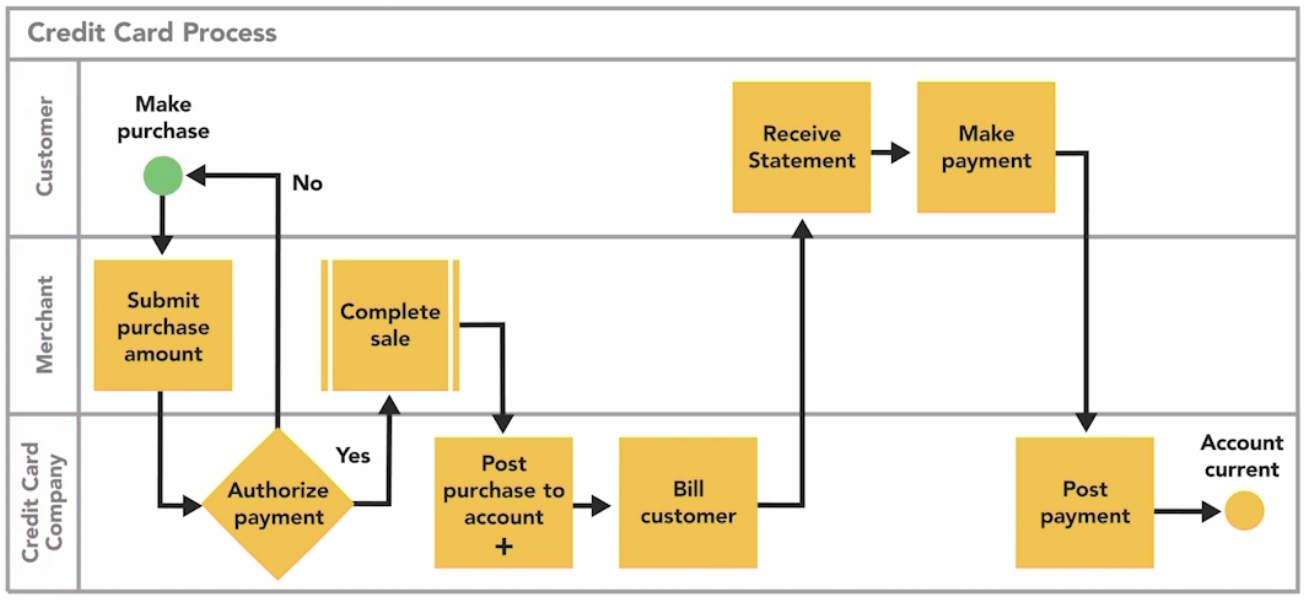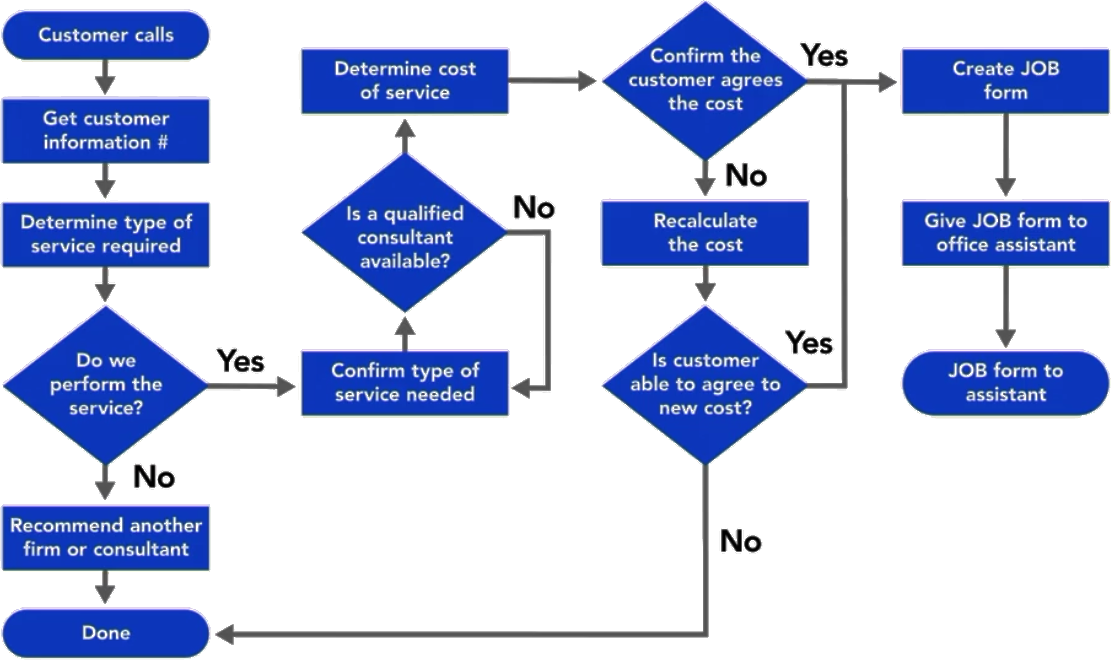Explore a Career in Business Analysis (LinkedIn Learning)
https://www.linkedin.com/learning/paths/explore-a-career-in-business-analysis
What Is Business Analysis?
https://www.linkedin.com/learning/what-is-business-analysis
Provide a bridge between technical and business viewpoints
As a
- Professional: Certification (IIBA, BCS, …)
- Competencies: e.g. facilitation, problem-solving, negotiation, industry/organisational knowledge
- Research
Career paths
- Internally, from a commercial (marketing, sales, finance) role
- Internally, from an IT role (e.g. product support)
- As a graduate who enjoys problem solving, research, analysis
Business Analysis Foundations
https://www.linkedin.com/learning/business-analysis-foundations-4
Introduction
“The practise of enabling change in the context of an enterprise by defining the needs and recommending solutions that deliver value to stakeholders” - IIBA
“The process by which we identify business needs, recommend relevant solutions, and understand requirements.“xxxxxxx
Activities: understand current needs; focus on strategic objectives; help achieve goals
Can act at a business or project level
Skills: business acumen, analytical, communication
Needs assessment
Categories of needs
- Problems or possible improvements
- Opportunities or new endeavours
- Compliance requirements
Process
- Identify the problem
- Assess the current state
- Discern the future state
- Determine the gaps
Situation statement
- The problem or opportunity
- has the effect of X
- with the resulting impact of Y.
Tools
- Ishikawa diagram
- Five Whys
Solution statement
Sentence recommending the most viable option to meet the needs while also defining initial scope and steps.
But always provide multiple options.
Feasibility study
Stakeholders
“An individual, group, or organisation that may affect, be affected by, or perceive itself to be affected by a decision, activity, or outcome of a project.” - PMBOK
Classifying: Power vs Interest matrix
Stakeholder engagement: format, content, timing
Business case
Documents benefits and justifies costs
Components: Situation statement, stakeholders, scope, relationship with organisational strategies, (root cause) analysis, success factors, potential gaps, risk assessment, assumptions, milestones, roles and responsibilities, financials (payback period, NPV, IRR, ROI, …), alternatives, …
Planning
Vision (short, precise, aligned across teams → an elevator pitch): Why, what, who, when, where, how
Involves: Sponsor, PM, BA, stakeholders
Roadmap with milestones
BA gives PM: activities needed to elicit, analyse, and evaluate requirements, and activities tracing, veriyfing, and validating requirements
Sometimes BA and PM roles are combined
Determining requirements
Types
- Business: high level needs of the organisation
- Stakeholder: internal or external
- Solution: features, functions, characteristics
- Functional: e.g. webstore
- Non-functional: e.g. security
- Transition: activities to move from current to future state e.g. training
- Project: PM responsibility
- Quality: QA responsibility
Elicitation
Facilitated sessions, interviews (structured, semi, unstructured), …
Modelling
- Process modelling: verbs → determine the process
- Data modelling: nouns → determine the product/customer
Traceability and monitoring requirements
Traceability approach (how requirements are related) and traceability matrix (tool for tracking e.g. Kanban board)
Change control and configuration control (using version control)
Evaluating the solution
Verification (conforms with specification) + validation (confirm results meets acceptance criteria and stakeholder needs)
Use RACI to ensure everyone is communicated with correctly
Preparing for release and transition
Release plan: Who is it being released to? Can it (or must it) be deployed in (prioritised) stages?
Transition plan: Pilots, old and new simultaneous and phase out, or Big Bang. Is training needed?
Monitor implementation to ensure requirements were met and see future potential improvements
Strategic Business Analysis Essentials
https://www.linkedin.com/learning/strategic-business-analysis-essentials
Business Solutions through Strategic Analysis
- Map out the roadmap from current to future state
- Consider ways to minimise business risk
- Anticipate how to increase adoption while achieving the desired outcome
Define the aim. Is it a problem or an opportunity?
Skills
- Be a listener
- Be a simplifier
- Be transparent
Strategic Business Analysis Process and Outcomes
Analyse current state
Why it needs to change and what will be affected (directly or indirectly)
Need to understand:
- Organisational needs
- Organisational structure and cultures
- Capabilities and processes
- Technology and infrastructure
- Policies
- Business architecture
- Internal assets
- External influencers
Define future state
Can be done in parallel with analysing current state
Determine the set of necessary conditions to meet the business need
Assess risks
Identify, timing, circumstances, solutions, recommendation, etc
Severity vs Likelihood matrix
Check for unknowns, constraints/assumptions/dependences, negative impacts to value, risk tolerance
Define change strategy
- Solution scope
- Gap analysis
- Enterprise readiness assessment
- Change strategy recommendation
Plan for the transition state
- Organisational ability to absorb change
- Change heat map
- Timing for change
- Timeline to deliver benefits
- Alignment of change
Strategic BA Tools and Techniques
PESTLE
Political Economical Social Technological Legal Environmental
Porter’s Five Forces
Competition in the industry; potential of new entrants into the industry; Power of suppliers; power of customers; threat of substitute products
MOST and Resources Audit
Mission Objectives Strategy Tactics
Current tangible and intangible resources
BCG Matrix
Growth-Share: Cash cow, star, question mark, dog
Ansoff’s Matrix
Markets vs Products/Services
Existing vs New
Market Penetration, Market Development, Diversification, Product Development
SWOT
Strengths Weaknesses Opportunities Threats
Business Analysis Foundations: Business Process Modelling
https://www.linkedin.com/learning/business-analysis-foundations-business-process-modeling
Process
- Capture processes
- Provide visual representation
- Identify what’s needed
In modelling, stakeholders = actors (person, system, or functional area)
Modelling languages: UML and BPMN
Tool: Visio
1. Context Diagram
Circle is what you have control over (i.e. organisation), box represents what you have influence over
Don’t get too complex e.g. group different suppliers into single supplier entity if the same processes/relationships
2. Functional Flow Diagram
Start with external entity e.g. customer
Focus on a single interaction
Focus on the what is transacted not how
3. Cross-Functional Flow Diagram
Circle = start/stop (terminator), rectangle = process, parallel lines = sub-process, plus symbol = expansion, diamond = decision, arrows
Verb-noun combination
Rule of thumb: no more than 16 boxes
4. Flowchart Diagram
aka Process Maps
KRAC: Keep Remove Add Change
Enables impact assessments
Focus on a single functional area
Business Analysis Foundations: Competencies
https://www.linkedin.com/learning/business-analysis-foundations-competencies
Relationship building and management
Co-creating: shared understanding of big picture and requirements details
Rapport and empathy: “what does success look like?” “so what I’m hearing is…”
Conflict management: separate people from the problem; focus on the desired outcome and organisational goals
Leadership
Influence without authority: understand their resistances and receptiveness, align to their motivations
Decision-making: know who the decision-makers are, what the decisions are, and what data is needed to make the decisions
Change management: identifying impact groups and how to support them
Facilitation
Meetings: agendas with purpose, objective, topcs (from their perspective); make sure everyone is heard
Conversations: open, thought-provoking questions; break into pairs/small groups then collate
Requirements processes: requirements evolve and emerge over time
Communication
Verbal: phrasing and tone of questions, summarisations, general information
Listening: hearing for intent not only the words; for logic and biases
Visual: tables, matrices, diagrams, models
Written: story from the user’s point of view; clear asks/next steps
Business
Business: how the product/project strategically aligns to the organisation and which teams it affects; what the KPIs are; who the organisation’s customers are
Innovation: discover → develop → deliver
Architecture and processes: enables seeing existing links/systems across/in the organisation and relating to the product/project
Analytical
Systems thinking: break down big concepts to smaller pieces, how one thing impacts another
Creativity: also fostering creativity in others
Visual modelling and diagrams: for communication, analysis, catch unstated requirements
Data analysis: understand, identify, find meaning, flows, relationships, connections, gain insights
Curiosity: ask questions (with the right tone), challenge assumptions
Technical
Productivity tools
Technology landscape: future trends e.g. AI
Data, process, and rules: e.g. shipping address, web form, data format validation

